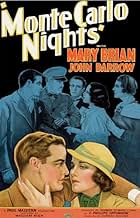PUNTUACIÓN EN IMDb
5,1/10
176
TU PUNTUACIÓN
Añade un argumento en tu idiomaA man wrongfully convicted of murder escapes custody and goes in search of the real killer. The problem is that he only has one clue to go on.A man wrongfully convicted of murder escapes custody and goes in search of the real killer. The problem is that he only has one clue to go on.A man wrongfully convicted of murder escapes custody and goes in search of the real killer. The problem is that he only has one clue to go on.
George 'Gabby' Hayes
- Inspector Nick Gunby
- (as George Hayes)
Eddie Baker
- Motor Patrolman
- (sin acreditar)
George Byron
- Detective
- (sin acreditar)
Yakima Canutt
- Casino Hood
- (sin acreditar)
Jack Cheatham
- Detective on Train
- (sin acreditar)
Jack Chefe
- U.S. Gambling Club Bouncer
- (sin acreditar)
André Cheron
- Madelon's Uncle
- (sin acreditar)
Gino Corrado
- Monte Carlo Casino Gambler
- (sin acreditar)
Richard Cramer
- Detective
- (sin acreditar)
Argumento
¿Sabías que...?
- CuriosidadesThe failure of the original copyright holder to renew the film's copyright resulted in it falling into public domain, meaning that virtually anyone could duplicate and sell a VHS/DVD copy of the film. Therefore, many of the versions of this film available on the market are either severely (and usually badly) edited and/or of extremely poor quality, having been duped from second- or third-generation (or more) copies of the film.
- PifiasTwice at the roulette table, the croupier calls out "Double zero." Monte Carlo casinos do not use double zeros.
- ConexionesFeatured in El largo camino (1934)
Reseña destacada
A reviewer needs to give really old movies a lot of latitude. That is particularly true regarding visuals and sound, but also to a lesser extent the story. Hitchcock was perhaps an exception. But a lot of latitude still allows one to critique on points that any filmmaker should have been aware of, even in those days.
The most significant problem here is a plot that is rushed. I can accept that 1930s Hollywood is responsible for the conspicuous absence of pauses between lines of dialogue. This is typical of films back then; it conveys the impression that the runtime is being clocked with a stopwatch.
But in this film some scenes don't connect well, and I'm left with the impression that connecting scenes may have been cut out. How else are we to explain Inspector Gunby's assumption that Larry is innocent? Then there's that scene where Larry appears at the window at Mary's home; how did he get there from his escape location? How did he manage to get from Mary's home to Monte Carlo? None of these actions are explained. Were connecting scenes edited out? If yes, why? If, on the other hand, this is the way the scriptwriter wanted the plot to play, then it's a poorly written script. Either way, the film, at barely sixty minutes, appears forced into a runtime straight-jacket.
Production values are acceptable for the era. B&W photography is about what one would expect, grainy, and with the use of static camera shots. Casting could have had more diverse looking females. Acting was a bit exaggerated at times, not unusual for early talkies.
I suppose one could say that "Monte Carlo Nights" is a suspense film; there's a little, not much. The ending contains a slight story twist, but one that is not satisfying. The overall whodunit resolution here is disappointing. Other whodunit films from the same era are better.
The most significant problem here is a plot that is rushed. I can accept that 1930s Hollywood is responsible for the conspicuous absence of pauses between lines of dialogue. This is typical of films back then; it conveys the impression that the runtime is being clocked with a stopwatch.
But in this film some scenes don't connect well, and I'm left with the impression that connecting scenes may have been cut out. How else are we to explain Inspector Gunby's assumption that Larry is innocent? Then there's that scene where Larry appears at the window at Mary's home; how did he get there from his escape location? How did he manage to get from Mary's home to Monte Carlo? None of these actions are explained. Were connecting scenes edited out? If yes, why? If, on the other hand, this is the way the scriptwriter wanted the plot to play, then it's a poorly written script. Either way, the film, at barely sixty minutes, appears forced into a runtime straight-jacket.
Production values are acceptable for the era. B&W photography is about what one would expect, grainy, and with the use of static camera shots. Casting could have had more diverse looking females. Acting was a bit exaggerated at times, not unusual for early talkies.
I suppose one could say that "Monte Carlo Nights" is a suspense film; there's a little, not much. The ending contains a slight story twist, but one that is not satisfying. The overall whodunit resolution here is disappointing. Other whodunit films from the same era are better.
- Lechuguilla
- 26 jun 2014
- Enlace permanente
Selecciones populares
Inicia sesión para calificar y añadir a tu lista para recibir recomendaciones personalizadas
Detalles
- Duración1 hora 2 minutos
- Color
- Relación de aspecto
- 1.37 : 1
Contribuir a esta página
Sugerir un cambio o añadir el contenido que falta

Principal laguna de datos
By what name was Noches de Monte Carlo (1934) officially released in Canada in English?
Responde
















